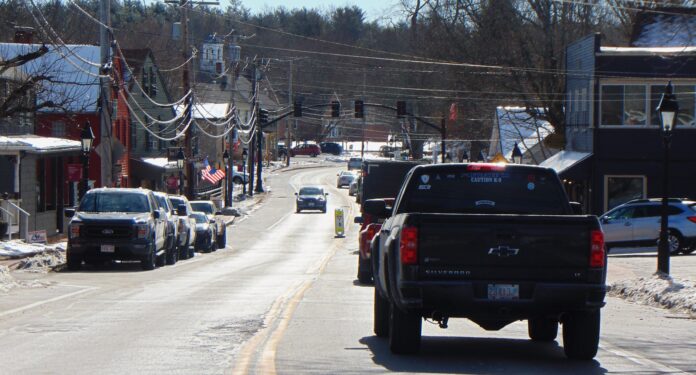GLOCESTER – The first step toward bringing potable water to Chepachet Village, a study of potential options, was presented recently to the Glocester Town Council by Robert Ferrari from Northeast Water Solutions, the firm tasked with exploring the possibilities and developing a comprehensive plan for the project.
The year and a half study examined existing conditions and assessed viable alternatives for delivering potable water to village residents and businesses.
Lack of public water and sewer infrastructure is considered one of the major obstacles to business expansion and development in the village. Installing individual wells and wastewater treatment systems, which the village now relies on, is often too costly for residents and small businesses. It also limits the use of extra space for things such as creation of affordable housing.

“We tried to look at all aspects of water supply and identify all existing conditions that might be beneficial to the growth and well-being of the community,” Ferrari explained.
Among concerns for those looking at the issue is the fact that the majority of lots located in or near the village are undersized, have inadequate water yield and can not contain wells that would adequately provide water to homes and businesses in the area. Existing well water throughout the village is variable in terms of contaminants, with varying degrees of elevated levels of manganese, chloride and iron. Building a public well in the area is not feasible, since, by law, a 200 foot radius is required. There simply isn’t room in the historic village, where buildings are close together. Additionally, certain conditions must exist in order for the well to provide sufficient water.
“Building a public well would mean we are, literally, into wells, septic systems, public roads, drainage systems…” said Ferrari.
Even private wells, he said, require a 100 foot radius. Current buildings, septic systems and wells were constructed before present day codes, and federal, state and local requirements have changed both for fresh water and septic. The septic systems currently in place, Ferrari said, are a constant threat to wells in the area, some of which already contain elevated amounts of iron, for example, which causes pipes to deteriorate over time. The study found that Dino’s Market had the best water quality of the sites tested throughout the village. The reason for that, Ferrari said, is the granite formations found in the area, which influenced the underground aquifers.
“This geology is why you have some low yielding wells in town and some high yielding wells also,” he said.

The purpose of the study was to determine if there are viable water supply sources available, establish criteria specific to the community to protect public health, provide an operationally effective public water system, minimize public health risk and develop capital budgets to address the project with several alternatives for implementation.
“Every project has to be specific for the community you are in,” explained Ferrari. “Every community is unique.”
The average estimated demand for potable water in the village is 66,336 gallons-per-day, with a maximum daily demand of 92,000-per-day. Where to get that amount of water was the big question. Ferrari said there were two possible solutions: extend the Clear River Electric and Water Utility District and use the Steere Farm well field, or create an independent Chepachet Municipal Water System, utilizing five well field sources in the area. Developing smaller water supply wells and water treatment systems for each lot would not be physically effective or cost effective, he said, and would only add to more contamination problems in the future.
“The town’s objective was how to comprehensively serve the entire Chepachet Village,” said Ferrari.

The infrastructure in the village would include 12 inch and eight inch distribution pipes with valves, 28 hydrants, 140 service connections, and a crossing over Chepachet River, which dissects the village, as well as construction on state, federal and town roads. The cost was estimated at $7,845,450.
“A large part of the cost is construction in state roads and U.S. Route 44,” Ferrari said.
State and federal regulations for construction – particularly for traversing a bridge – add to the costs.
“Obviously, Route 44 coming across Chepachet River, you’ve got some real constraints there,” explained Ferrari.
Additionally, a 300,000-gallon storage tank about 100-150-feet-high would need to be constructed to provide water pressure, as well as ensure water availability. The tank would have to be placed in a nearby elevated area and would cost about $7 million.
“It’s a pretty standard structure,” Ferrari said. “If you drive around, you’ll see a lot of tanks of that nature in Rhode Island and nearby Massachusetts.”
On the basis of the extensive study, he said the best alternative is to connect with the neighboring Clear River Electric & Water system. A connection, he said, was determined to be the highest ranked alternative, based upon total project cost, source capacity and water quality, and achievement of the project’s objectives. The overall cost would be $22-23 million, but the capital cost would be shared with CREW, reducing Glocester’s cost to $15-17.5 million. Operating cost would be an estimated $228,330 per year.
“We believe we have very good accuracy on our estimates,” he said. “We’ve been doing this a long time. We have confidence in our estimates moving forward.”
Ferrari’s firm worked with the Pascoag Utility District to develop new water sources in recent years. The Burrillville-based quasi-public system recently merged with the Harrisville Fire District Water Department to become Clear River Electric & Water.
The engineer also gave a presentation last week on a somewhat different topic: the mechanisms in place to ensure the a local mining company won’t contaminate nearby water in North Smithfield.
Ferrari noted that there are a number of community grants and funding available that could help offset the cost of the Chepachet project.
“Hypothetically, if we started tomorrow, how long to put a shovel in the ground” asked Council Vice President Walter Steere.
Ferrari said if the town started the project tomorrow, construction might begin in 18 months, after all permits, design, hearings, bids and other paperwork were completed. Then, it would probably take about four years to complete the actual work. If the town goes with a connection to the neighboring district, it might take slightly less time, he said, partly due to the fact there would be less paperwork.
“There can be a lot of factors,” said Ferrari of the option of creating a village system. “You would have to create a new water district. That might require legislation…things like that. There are considerations like that that can have potential time impact.”
The council thanked Ferrari, but made no decisions.

The Implementation Plan for Decentralized Wastewater Improvements is the second part of the town’s overall plan. That will explore opportunities for innovative and alternative septic systems, educating property owners of different possibilities available and, where individual systems are not feasible, looking for opportunities to join with neighboring property owners with comparable wastewater needs and providing incentives to property owners to implement these recommendations. The $915,000 project is funded through a $250,000 Southeast New England Program, a Watershed Implementation Grant for $465,000, an EPA Decentralized Wastewater Grant and $200,000 of the town’s American Recovery Plan Act funds, as well as staff time to oversee the implementation of the project.
“The town has repeatedly invested its limited funds in improvements to Chepachet Village and made changes to its regulations to ensure that private investment also conforms to the overall vision for the area,” said Town Planner Karen Scott. “While the town has been driving the implementation of public infrastructure investments and regulatory reforms, the town felt it was also important to find ways to incentivize and assist local property owners to invest in their properties to not only beautify their exteriors but to attract new economic development and new residents to Chepachet Village, while maintaining its rural character as a historic village center.”
Both projects are part of the town’s overall goal – since the 1990s – of creating an environment in which Chepachet Village’s resources can thrive and expand. The town, in partnership with other agencies, has already seen the implementation of more than $15 million in infrastructure investment contributing to the village’s character as a historic, walkable commerce center, including new brick sidewalks and crosswalks, period lighting, street trees, planters, new signage and a new roundabout replacing the only stoplight in the district.








Maybe they should fix the crappy water in harrisville before they add more some people can’t drink the water in harrisville Rhode Island
So if you’re thinking of installing both water and sewer wouldn’t it make more sense to install both at the same time while having the roads dug up? Connect all buildings with both at the same time and also install any other underground utilities so that the roads wouldn’t have to be dug back up again and again like what usually happens, then the road can be paved once without a bunch of patching here and there